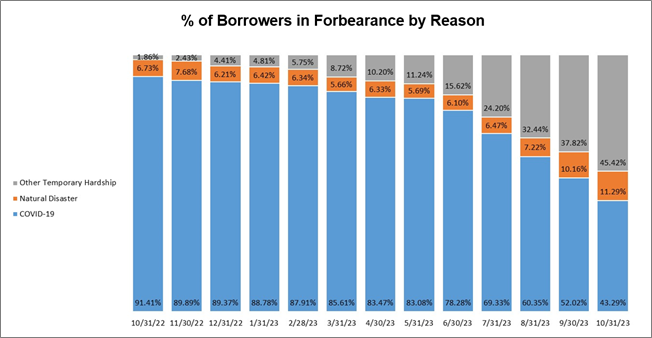 The Mortgage Bankers Association’s (MBA) latest Loan Monitoring Survey shows that the total number of loans now in forbearance decreased by three basis points from 0.29% of servicers’ portfolio volume in the prior month to 0.26% as of November 30, 2023.
The Mortgage Bankers Association’s (MBA) latest Loan Monitoring Survey shows that the total number of loans now in forbearance decreased by three basis points from 0.29% of servicers’ portfolio volume in the prior month to 0.26% as of November 30, 2023.
According to MBA’s estimate, 130,000 homeowners are currently in forbearance plans. Mortgage servicers have provided forbearance to approximately 8.1 million borrowers since March 2020.
In November 2023, the share of GSE loans (Fannie Mae and Freddie Mac) in forbearance declined two basis points from 0.18% to 0.16%. Ginnie Mae loans in forbearance decreased five basis points from 0.52% to 0.47%, and the forbearance share for portfolio loans and private-label securities (PLS) decreased two basis points from 0.32% to 0.30%.
“Nearly 96% of all home mortgages are performing, which underscores how strong servicing portfolio performance is right now with the same resilience seen in the U.S. labor market,” said Marina B. Walsh, CMB, MBA’s VP of Industry Analysis. “Meanwhile, the performance of loan workouts is solid, but declined last month. Roughly 70% of loan workouts initiated since 2020 are current.”

By reason, 53.6% of borrowers are in forbearance for reasons such as a temporary hardship caused by job loss, death, divorce, or disability; while 34.3% of borrowers are in forbearance because of COVID-19. Another 12.1% were in forbearance due to a natural disaster.
By stage, 49.0% of total loans in forbearance are in the initial forbearance plan stage, while 35.1% are in a forbearance extension. The remaining 15.8% are forbearance re-entries, including re-entries with extensions.
“MBA forecasts an economic downturn in 2024, and there are signs of early distress in other credit types such as car loans and credit cards,” added Walsh. “Those borrowers who struggled in making their mortgage payments in the past may find themselves in similar situations in a softening economy and rising unemployment.”
According to Bureau of Labor Statistics (BLS), total nonfarm payroll employment increased by 199,000 in November, and the unemployment rate edged down to 3.7%. Job gains occurred in healthcare and government. Employment also increased in manufacturing, reflecting the return of workers from a strike. Employment in retail trade declined.
Of the cumulative forbearance exits for the period from July 1, 2020, through November 30, 2023, at the time of forbearance exit:
- 29.4% resulted in a loan deferral/partial claim.
- 17.7% represented borrowers who continued to make their monthly payments during their forbearance period.
- 18.4% represented borrowers who did not make all of their monthly payments and exited forbearance without a loss mitigation plan in place yet.
- 16.1% resulted in a loan modification or trial loan modification.
- 10.8% resulted in reinstatements, in which past-due amounts are paid back when exiting forbearance.
- 6.5% resulted in loans paid off through either a refinance or by selling the home.
- The remaining 1.2% resulted in repayment plans, short sales, deed-in-lieus or other reasons.
The five states with the highest share of loans that were current as a percent of servicing portfolio included:
- Washington
- Colorado
- Idaho
- Oregon
- Montana
The five states with the lowest share of loans that were current as a percent of servicing portfolio included:
- Louisiana
- Mississippi
- Indiana
- New York
- Illinois
Total completed loan workouts from 2020 and onward (repayment plans, loan deferrals/partial claims, loan modifications) that were current as a percent of total completed workouts decreased to 71.28% in November from 72.30% the previous month.

 DSNews The homepage of the servicing industry
DSNews The homepage of the servicing industry









